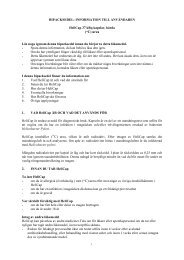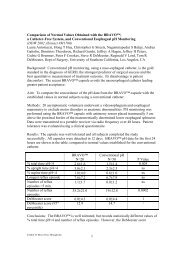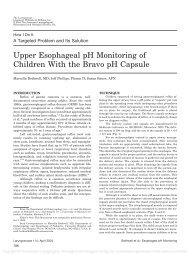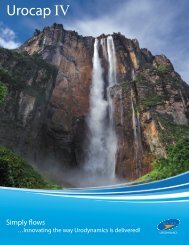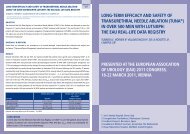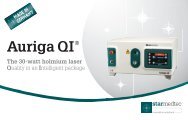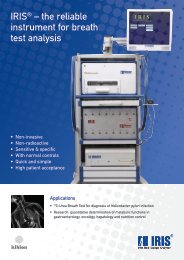Comparison with High Resolution Manometry
Comparison with High Resolution Manometry
Comparison with High Resolution Manometry
Create successful ePaper yourself
Turn your PDF publications into a flip-book with our unique Google optimized e-Paper software.
A Novel Portable Device to<br />
Measure Anorectal Pressures:<br />
<strong>Comparison</strong> <strong>with</strong> <strong>High</strong> <strong>Resolution</strong><br />
<strong>Manometry</strong><br />
Adil E. Bharucha 1 , Kelly Feuerhak 1 , Randolph<br />
Stroetz 2 , A.R. Zinsmeister 3 .<br />
1<br />
Clinical Enteric Neuroscience Translational and<br />
Epidemiological Research Program,<br />
2<br />
Department of Anesthesiology, and 3 Division of Biomedical<br />
Statistics and Informatics,<br />
Mayo Clinic, Rochester, MN
Background<br />
• Anorectal manometry is used to diagnose defecatory<br />
disorders and identify anal weakness in fecal<br />
incontinence<br />
• <strong>Manometry</strong> is only conducted in specialized<br />
laboratories; requires cumbersome equipment and<br />
considerable expertise<br />
• These limitations may hinder more widespread<br />
utilization of anorectal manometry<br />
• A portable device may increase access to manometry<br />
in clinical practice
Aims<br />
• To compare anorectal pressures measured by a<br />
portable anorectal manometry device to high<br />
resolution manometry (HRM) in<br />
– Healthy women<br />
– Women <strong>with</strong> chronic constipation and<br />
– Women <strong>with</strong> fecal incontinence
Eligibility Criteria<br />
• Healthy women (18-75y)<br />
– No functional bowel disorder or fecal incontinence (Rome III<br />
criteria)<br />
– No medications that affect anorectal functions<br />
– No risk factors for pelvic floor trauma (> 2 vaginal deliveries,<br />
birthweight >4500gms, 4th degree perineal tear, anorectal<br />
procedures)<br />
• Women <strong>with</strong> chronic constipation or constipation-predominant IBS<br />
• Women <strong>with</strong> fecal incontinence for ≥ 1 year<br />
• Exclusion criteria common to controls and patients<br />
– Clinical evidence of significant cardiovascular, respiratory,<br />
renal, hepatic, gastrointestinal, hematological, neurological,<br />
psychiatric or other disease that may interfere <strong>with</strong> the study<br />
– Prior pelvic radiation<br />
– History of or current inflammatory bowel disease
Study Procedure<br />
• Anorectal pressures measured on the same day by<br />
– <strong>High</strong> resolution manometry (Given Imaging)<br />
– Hand-held anorectal manometry device (mcompass,<br />
Medspira Inc)<br />
• Pressures were measured at rest (20s), squeeze (3<br />
maneuvers 20s each), Valsalva maneuver (20s) and<br />
simulated evacuation (before and during rectal distention<br />
[50 ml])<br />
• Rectal sensation was assessed during balloon distention<br />
– From 0-200 ml (or maximum tolerated volume) in 20 ml<br />
steps<br />
– Thresholds for first sensation, desire to defecate and<br />
maximum urgency
Mcompass Anorectal <strong>Manometry</strong> System<br />
Medical-grade<br />
tablet<br />
Catheter<br />
Rectal balloon<br />
4 anal cushions<br />
Bluetooth<br />
Electronic<br />
FOB
Diameter of<br />
sensing portion<br />
Recording<br />
sensors<br />
<strong>High</strong> resolution<br />
manometry<br />
4.2 mm 9 mm<br />
• One at each level<br />
• ~ 10 levels (6 cm)<br />
Hand-held<br />
manometry<br />
• 4 radial balloons<br />
(2 cm long)<br />
Measurement <strong>High</strong>est of 10<br />
pressures at any<br />
instant in time<br />
Resting pressure Average (20 s) Average (20 s)<br />
Maximum<br />
squeeze<br />
Simulated<br />
evacuation<br />
• <strong>High</strong>est pressure -<br />
each (of 3)<br />
maneuvers<br />
• Average - 3 values<br />
<strong>High</strong>est rectoanal<br />
gradient (2s)<br />
• Average pressure,<br />
each balloon, 3<br />
maneuvers<br />
• Maximum value<br />
<strong>High</strong>est rectoanal<br />
gradient (2s)
Statistical Analysis<br />
• Anorectal pressures measured by 2 techniques were<br />
compared by<br />
– Lin’s concordance statistic (the concordance correlation<br />
coefficient [CCC]), which assesses both accuracy and<br />
association of agreement whereas the usual (Pearson)<br />
correlation assesses association alone<br />
– Bland Altman test
Participants<br />
• Healthy women<br />
– n = 17, age 41 ± 4y, BMI 26.3 ± 0.9 kg/m 2<br />
• Chronic constipation or constipation-predominant IBS<br />
– n = 16, age 40 ± 2y, BMI 27.0 ± 1.0 kg/m 2<br />
– 11 had abnormal balloon expulsion test<br />
• Fecal incontinence<br />
– n = 6, age 53 ± 4y, BMI 25.0 ± 1.0 kg/m 2<br />
– Minor (n=1) or moderate (n=5) symptoms by FICA symptom<br />
severity score 1<br />
1 Bharucha AE, APT 2004; 2 CGH 2006.
Rest<br />
0 50 100 150 mmHg<br />
Squeeze<br />
Defecation Sensation<br />
Rectal<br />
Balloon<br />
9.4<br />
8.8<br />
Balloon<br />
0.6<br />
Rectum<br />
5.4<br />
4.8<br />
4.2<br />
3.6<br />
Anus<br />
3.0<br />
2.4<br />
1.8<br />
20 seconds<br />
1.2<br />
0.6<br />
0.0
Representative Tracing - mcompass<br />
Rest Squeeze Defecation Sensation<br />
Rectal<br />
Balloon<br />
Anus<br />
20 seconds
<strong>Comparison</strong> of Anal Resting and Squeeze<br />
Pressures<br />
Mean resting pressure<br />
Anal resting pressure (mmHg, hand-held)<br />
Maximum squeeze pressure<br />
Anal squeeze pressure (mmHg, hand-held)<br />
180<br />
150<br />
120<br />
90<br />
60<br />
30<br />
0<br />
Controls<br />
Constipation<br />
Fecal incontinence<br />
CCC = 0.45 (0.27, 0.59)<br />
0 30 60 90 120 150 180<br />
Anal resting pressure (mmHg, HRM)<br />
350<br />
300<br />
250<br />
200<br />
150<br />
100<br />
50<br />
0<br />
Controls<br />
Constipation<br />
Fecal incontinence<br />
CCC = 0.50 (0.34, 0.63)<br />
0 50 100 150 200 250 300 350<br />
Anal squeeze pressure (mmHg, HRM)
ifference in Values between Methods was Related t<br />
Magnitude of Pressure<br />
Bland Altman Test<br />
p = 0.0001<br />
p = 0.0001
<strong>Comparison</strong> of Anal Pressures<br />
Pressure HRM mcompass CCC<br />
(95% CI)<br />
Mean –<br />
rest<br />
78 ± 4 56 ± 3 0.45<br />
(0.27, 0.59)<br />
Max - rest 89 ± 5 62 ± 3 0.40<br />
(0.23, 0.55)<br />
Max - 189 ± 10 130 ± 7 0.50<br />
squeeze<br />
(0.34, 0.63)<br />
Max – 125 ± 9 89 ± 5 0.53<br />
valsalva<br />
(0.37, 0.66)<br />
Bland Altman<br />
test<br />
(p value)<br />
0.0001<br />
0.0001<br />
0.0001<br />
0.0001
<strong>Comparison</strong> of Anorectal Pressures during<br />
Simulated Evacuation<br />
Parameter HRM mcompass CCC (95% CI) Bland Altman test<br />
(p value)<br />
Without rectal distention<br />
Rectal pr 34 ± 3 33 ± 3 0.54 (0.28, 0.72) ns<br />
Anal pr 78 ± 4 54 ± 4 0.14 (-0.07, 0.34) 0.0001<br />
Gradient -44 ± 5 -21 ± 5 0.18 (-0.06, 0.40) 0.0014<br />
During rectal distention<br />
Rectal pr * 28 ± 5 40 ± 3 0.33 (0.09, 0.54) 0.0004<br />
Anal pr 75 ± 5 49 ± 3 0.31 (0.14, 0.47) 0.0001<br />
Gradient -46 ± 6 -9 ± 4 0.26 (0.09, 0.42) 0.0001<br />
* Adjusted for intrinsic compliance of balloon<br />
r = - 0.4 (p < 0.03 for rectal pressure versus balloon expulsion time)
<strong>Comparison</strong> of Rectal Sensory<br />
Thresholds<br />
Parameter<br />
HRM<br />
(ml)<br />
mcompass<br />
(ml)<br />
CCC<br />
(95% CI)<br />
First<br />
sensation<br />
54 ± 5 49 ± 4 0.62<br />
(0.39, 0.77)<br />
Urgency 82 ± 6 81 ± 5 0.62<br />
(0.40, 0.78)<br />
Pain 115 ± 7 112 ± 6 0.60<br />
(0.36, 0.77)<br />
Bland Altman<br />
test<br />
(p value)<br />
0.13<br />
0.46<br />
0.13
Summary<br />
• Anorectal pressures and rectal sensory thresholds<br />
measured by a hand held device (mcompass) are<br />
significantly correlated <strong>with</strong> HRM<br />
• Pressures measured by mcompass are lower than<br />
HRM<br />
• Differences between both techniques are related to<br />
magnitude of parameter<br />
– Differences were greater for higher values
Discussion<br />
• <strong>High</strong>er anal pressures <strong>with</strong> HRM than mcompass may<br />
be explained by differences between techniques<br />
– mcompass sensors are larger (9 mm vs 4.2 mm)<br />
– eSleeve option in HRM skews reported pressures<br />
higher 1<br />
For example, average resting pressure in healthy<br />
women (83 mm Hg) is higher than corresponding<br />
values recorded by traditional manometry (67– 75<br />
mm Hg in younger and 48– 62 mm Hg in older<br />
women 1<br />
1 Noelting J, et al. Am J Gastro 2012.



